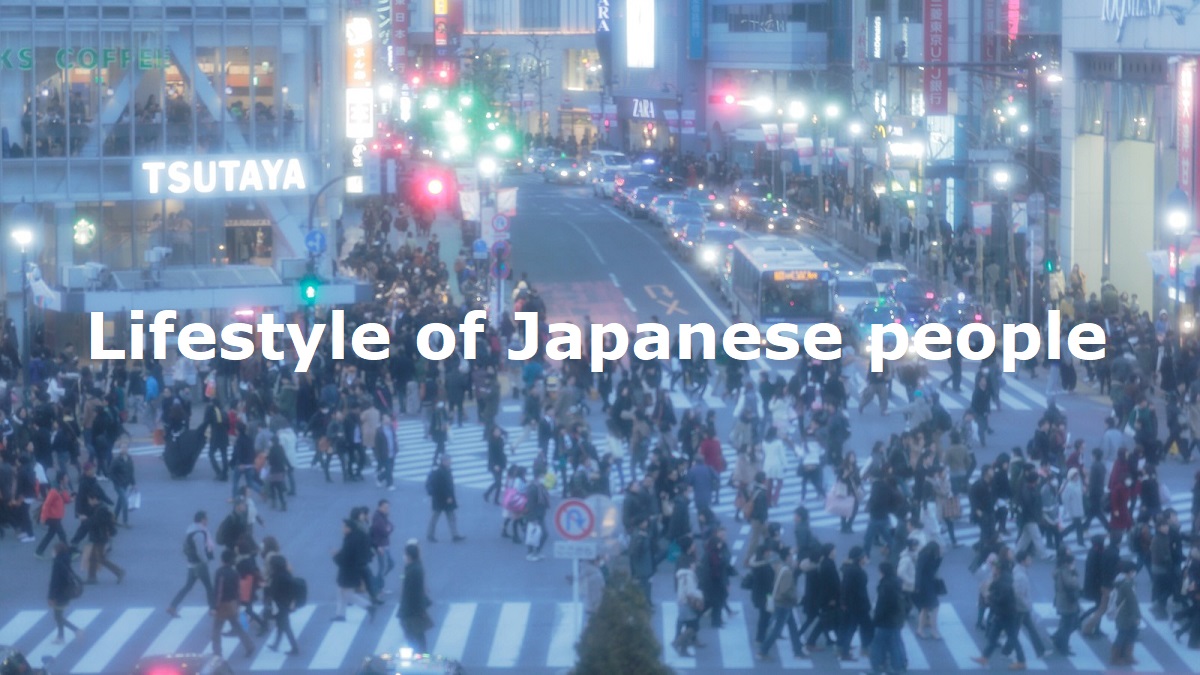Lifestyle of Japanese people
Lifestyle of Japanese people
About Japanese family
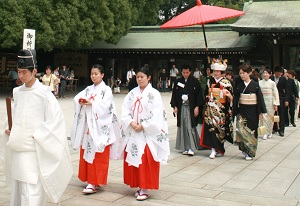
Japanese-style wedding ceremony in Meiji-jingu shrine in Tokyo
The life expectancy of Japanese people is 81.05 years for males and 87.09 years for female (2023).
It is the longest in the world.
By contraries, a woman has only about 1.26 children in a lifetime as the average number. (2023)
So, the rapidly declining birthrate and aging of the population continue in Japan now.
Japan has a population of about 124.5 million people in 2023, but the predicted population in 2050 is about 100 million.
Various works are concentrated in big cities.
Therefore, the population of Tokyo area and Kansai area is increasing but the population of the other areas is decreasing.
Especially, young people migrate to the city area away from their parents.
Many families in city area live with young parents and a few their children.
The children can meet their grandparents when their parents go back hometown only a few times in a year. (Mainly, in new-year vacation and Obon vacation in mid-summer)
So the children have only a little chances that they know the traditional information, wisdom and the pasttime of the family.
Probably many local traditional cultures are losing bit by bit.
About living
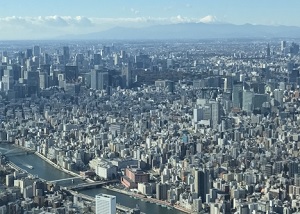
Scenery of central Tokyo and Mt.Fuji
In Japan, there are three big city areas.
They are Tokyo, Osaka and Nagoya areas.
The population of Tokyo area is about 34 million, Osaka area is about 18 million, and Nagoya area is about 11 million.
The total population of these areas is about half of whole Japan.
Especially, Tokyo area has over a quarter of the total population of Japan within 80-kilometer radius.
The people who want to live in such big city area must solve a difficult problem.
If a person hopes to live near central part of the city, the huge amounts of money to buy a house are needed.
On the other hand, if a person hopes to buy a house at a reasonable price, the target house is far away from the city.
Of course, the solution for many common people is the latter.
So, the commuting time is very long.
In Tokyo area, if it takes within one hour, the person is happy.
Some people spend over two hours to go to their workplaces.
Additionally the living space in Japan is narrow.
Once Westerner said "It's like a rabbit hutch".
In the city area, we can get easily a "Mansion" as living space.
Mansion in Japanese don't mean luxurious house but condominium.
Generally, it has two or three rooms and dining room with kitchen, and if it has four rooms, it is in large class.
The general price of such "Mansion" is four times more expensive than the annual income of the workers.
In the urban areas, detached houses are main.
However, the house area is small and the number of rooms in the house is not large.
Anyway, Japan is a narrow land.
About working
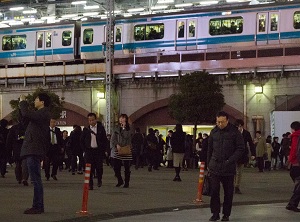
Workers returning to the home at Shinbashi station in Tokyo
It's said that Japanese people is diligent.
It is true that many of them work overtime and work on their day off.
Of course, one reason is that their works are too much to be completed.
But, overwork-deaths ("karoshi") and suicides by overwork are sometimes reported.
This is a problem of the employer.
Another implicit reason is that they want to earn overtime pay.
Because basic salary is not enough, they work overtime voluntarily and get more salary.
This is a problem of both the employer and the employee.
Diligence of Japanese people has some problems.
In addition, Japanese workers don't use fully their paid vacation.
And, only a handful of men take childcare leave.
The workplace is busy.
So, even now, many workplaces have the atmosphere that using paid vacation causes any inconvenience.
That is the remains of the high-growth period that working for the company is the virtue.
Therefore, even good leave system is not sufficiently utilized in Japan.
About eating
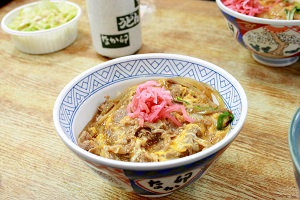
Donburi, a bowl dish of rice topped with any cooked food
Because working is most important for Japanese people, many hours of the day are spent for working.
Japanese people usually have a meal three times a day, but the time for each meal is short because of busyness.
In the morning, most people spend only a little time for breakfast, because they must go to far workplace.
Commonly lunch break starts at 12:00 and is within an hour.
They have lunch and take a break for this short time.
The dinner in the evening also ordinarily finishes within an hour.
Most Japanese people are accustomed to speedy eating.
Japanese people use chopsticks for eating.
Generally, they use them with the right hand, and we may hold a bowl of rice and soup with the other hand. (If you are left-handed, transpose "right" to "left".)
So they eat the food from the bowl brought close to our mouth.
I think that the pose makes the speedy eating.
Many workers work overtime, and the office is far from home.
So unfortunately most of family can't meet all members for dinner on weekday.
Living place of Japanese people
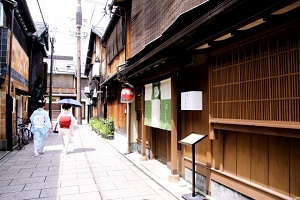
Wooden house street of Gion in Kyoto
As above, general houses in Japan are small.
Especially, various houses and condominiums are mixed without uniformity.
But, the outside and inside of the houses have the characteristics of traditional Japanese house.
Japanese traditional house is generally built of wood.
And paper is used as one of the materials of interior.
These fit the climate in Japan.
It is humid in summer.
Wood and paper control the moisture inside the house.
Japan has often experienced natural disasters such as earthquakes.
When a great earthquake destroyed a house, the residents in wooden house are safer than stone house.
So, Japanese people have built such wooden house.
Even magnificent Japanese castles are made of wood.
I introduce basic essence of Japanese house in the following page.
And, I also write the way to stay in Japanese room.
Kimono - Japanese traditional clothes
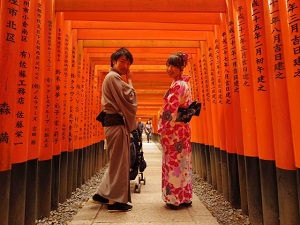
A couple wearing kimono
Japanese people usually wear worldwide common clothes.
Men wear trousers and women wear skirts.
Men wear suits and women wear dresses.
Not only young people but also elderly people like jeans.
In Japanese, these clothes are called as "Yofuku".
It means "Western clothes" in contrast with traditional Japanese clothes.
Kimono is well-known to foreigners as the traditional and beautiful Japanese clothes.
But, I think you are surprised that few Japanese people wear the kimono in the city.
Now, it is generally worn for such occasions as special ceremonies and parties.
Until the early 20th century, all Japanese had worn the kimono.
It is a little difficult for a person wearing kimono to move or run quickly.
Many people had fallen victim to the Great Kanto Earthquake in 1923.
It was thought that the disaster reduced the custom of wearing kimono.
After that, common Japanese people have become to wear the "Western clothes" and they have decreased the chance that they wear the kimono.
But it doesn't mean that Japanese people abandon kimono.
Rather, young people have worn kimono on the important days of the life.
When you visit Japan, you can experience wearing kimono in Asakusa in Tokyo and Kyoto.
But, it is good to know some knowledges about kimono.
I introduce them in the following page.
Religions in Japan
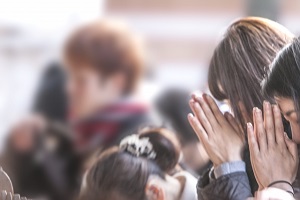
Worshipping at a temple
There are two main religions in Japan.
They are Shinto and Buddhism.
Most Japanese people believe in both these religions.
But many of them are not reverent believers.
Rather, the manner of the religions is a part of their daily life.
In addition, there are only about two million Christians and at most thousands of Muslims in Japan.
They are in the minority.
By the way, many Japanese people believing in Shinto and Buddhism also celebrate Christmas and Valentine's Day.
In short, Japanese perspective on religion is that believing and praying lead to happiness.
Therefore, Japanese people except for Christian don't receive baptism and can believe in multiple religions.
In addition Japanese are generally tolerant of the other religions, so outbreaks of religious conflict are rare in Japan.
Annual Events in Japan
Every month, there are some nationwide events in Japan.
They are national holidays and traditional events.
In some of the periods, many Japanese people travel across Japan.
When you visit Japan at that time, your travel may be affected by the situation.
On the other hand, you may know the traditional Japanese culture and customs in the period.
I introduce the main events in the following page.
Japanese name
Japanese name consists of family name and first name, and the order is (Family name) - (First name).
Of course, its pronunciation is based on Japanese language and many vowels are included.
So, it may be difficult for foreign people to pronounce.
Please know about Japanese name.

